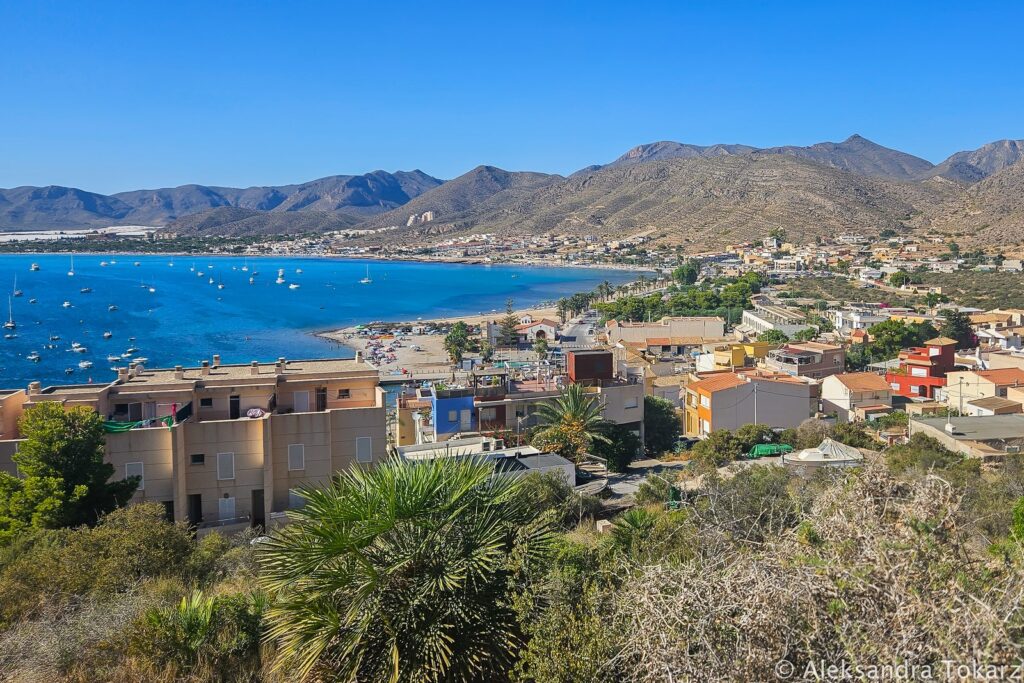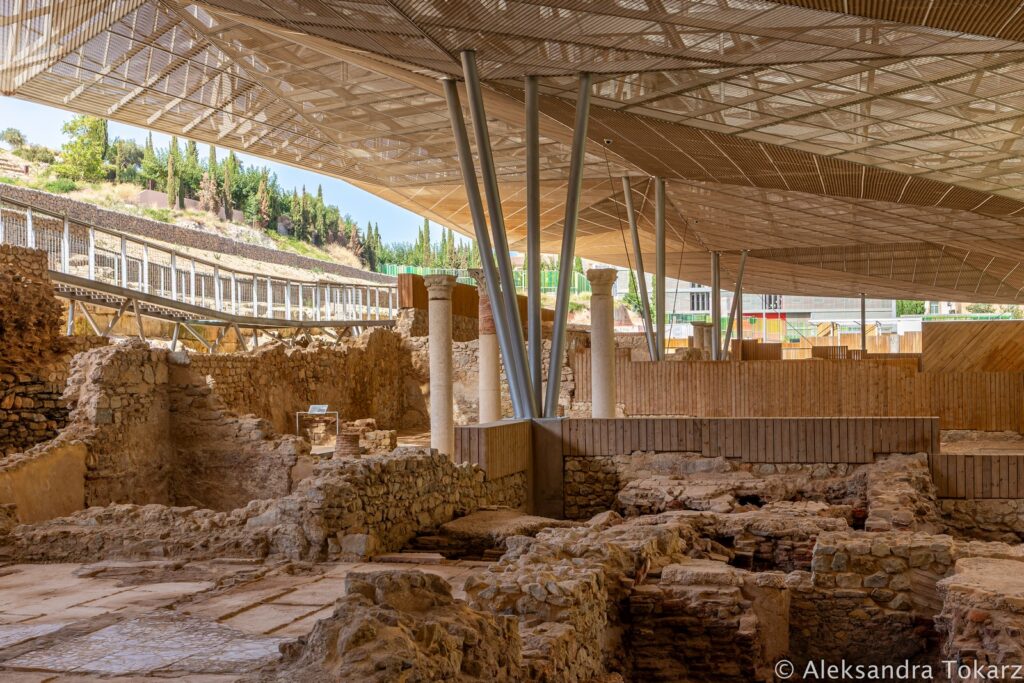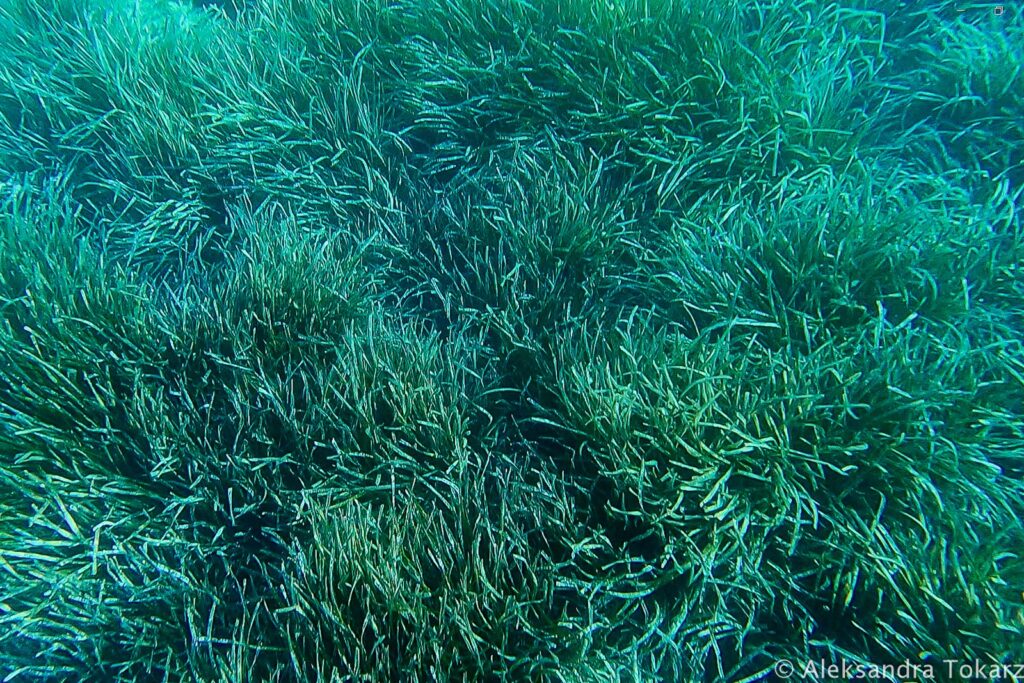Time for Module 10! As I promised, there is a good chance that you will finally read about sailing Balearic Islands 🙂 After a week spent with friends on the Costa del Sol, which I wrote about here, it is time to move on. It is the beginning of August, and we are just starting our adventure in the Mediterranean and warm, holiday sailing.
Benalmádena Marina, Spain
We leave Benalmádena in the early morning. We can breathe a sigh of relief, because our boat was being jerked so much in the marina (which I wrote about in the previous Module 9) that it was almost impossible to live on it. It is a good thing that we have strong cleats, otherwise we would have been seriously worried that they would be torn off. The cleats did the trick – unfortunately the mooring lines did not. They were worn out from constant tugging and should be thrown away.
When it comes to positive experiences with Benalmádena Marina, there are not many of them. However, we can certainly praise the security. Since we are mooring along the busy street, there were opinions among sailors about the lack of safety and cases of theft. Apparently, however, things have improved a lot in this regard, because we often saw security appearing on the quay. The security also reacted us when we boarded the boat at night.
La Azohia anchorage
Our further plan is to sail along the Spanish coast and pass to the Balearic Islands. After leaving Malaga, we head east towards Cartagena. As the last few months have been very busy, we do not sail straight to the city. After 186 miles, late in the evening, we stop at the La Azohia anchorage.
Anchoring at Night
When planning to reach our destination at night, we always try to choose bays that are large, with easy approach and without obstacles. In advance, we check on AIS and sailing apps if anyone is already there. This gives some insight into the situation, but not complete, because many yachts do not have position transmitters and do not use popular apps.
When entering, we use a very powerful torch to spot even those boats without any lights. Unfortunately, every time someone in the bay forgets to turn on the anchor light. Also, in sheltered bays, we often see “ghost boats” that are at anchor without crew or lights – probably someone stores them this way or simply abandoned them.
Nevertheless, in our opinion, turning on the anchor light is often not enough. When boats are anchored against the background of other lights in the area, e.g. city lights, shy anchor light gets lost. When approaching at night, they are completely invisible.
We ourselves use an additional strobe light, which we place on the stern to make our boat more visible. Although there are many opponents of additional boat lighting at night, we belong to those who prefer to be seen. The recent story and accident of a family from the popular YouTube channel Sailing La Vagabonde only confirms this belief. Although the details are not yet known as of the date of this publication, it is known that while they were at anchor, a passing fishing boat hit them in the middle of the night, and their new trimaran was seriously damaged.
But let’s get back to more pleasant things! The La Azohia anchorage is our first, typical holiday and beach spot during this cruise. Turquoise water, sun and a sandy beach are exactly what we need after the ice-bound Swedish marinas, the winter Baltic Sea or our stay in Poland. So we stay for a few days, resting, walking, swimming and snorkeling. Although there are a lot of boats here, the bay is large enough that this is not a problem even in the high season.
Sailing to Cartagena
Once we charge our batteries, we set off again. Our next stop is Cartagena, a historic city known for its impressive monuments, such as the Roman Theatre, and rich maritime tradition. The history of Cartagena is closely linked to the famous Hannibal. Hannibal, one of the greatest military commanders in history, used Cartagena as a key base for preparing his famous campaign against Rome during the Second Punic War. It was from here that he set off with his army and famous elephants on his legendary crossing of the Alps to Italy in 218 BC.
We spend the next day exploring the city, although the heat is unbearable. At this stage of the journey we haven’t had enough of the ancient ruins yet, so we visit, among other places, the Roman Theatre (Teatro Romano) with its very interesting museum next to it, and the remains of the Punic wall. In Cartagena there is also a well-restored Roman Forum with baths, temples and another museum. We definitely recommend all of these places! If you want to do a lot of sightseeing in Cartagena, like we did, we recommend buying one multi-ticket covering several monuments. Ask about it at the first place you visit.
What charmed us about Cartagena, apart from its rich history, is the intertwining of antiquity and modernity. Ancient ruins and monuments are an integral part of the city, and not, as is often the case, a fenced-off archaeological zone. Gray apartment blocks from the 1960s rise from Roman ruins, excavations are often located in the middle of housing estates, and the impressive Roman Theatre is in the very center of the modern city. In Cartagena, you can see very clearly how the city has changed and grown over the centuries. Its “layers” can be observed as if in the palm of your hand.
There are two marinas in the city, so of course we choose the cheaper one, the Real Club de Cartagena, which we manage to book by phone.
False start leaving continental Spain
The next afternoon we set off further east – this time our destination is the island of Ila de Tabarca, the smallest inhabited island in Spain. As we sail out of the port, we encounter an unpleasant situation. Tomek hits his head on the shroud while tidying up the deck so badly that… his glasses fall into the water. Unfortunately, the entrance to the port is not the right place to jump in and dive in search of them. The loss hurts, because you won’t get good sunglasses with corrective lenses immediately 🙁
Pissed off, we set off into the sea, the state of which doesn’t improve our mood at all. The wind is blowing almost straight into the bow, which means we’ll have to tack. The wave is big, the wind is strong, so the bow hits the masses of water with force. And sometimes the masses of water hit the boat. It’s really unpleasant and slow sailing, because the built-up wave effectively slows us down. We struggle for a few miles, but we come to the conclusion that we don’t want to and don’t have to. We’re not sailing to the schedule, we don’t have any deadlines, so we might as well sail the next day. So we turn back to Cartagena, but this time we anchor in front of the city, not entering the port. Sailing Balearic Islands will have to wait.
Unplanned stop in Torrevieja
We make another attempt to get further east the next day. The weather is more favorable, so sailing is much better. However, we change our plans, we won’t sail to the island of Ila de Tabarca, but to Torrevieja, still on the mainland. We need to sail into town to buy new sunglasses. Obviously, you can’t sail without them in the summer, and the old ones are lying somewhere on the bottom at the entrance to Cartagena. In Torrevieja, we also stop at an anchorage, by the salt port. There are a lot of boats here, but we still manage to find a place. If you ever plan to stop here, check for updates. Every now and then you hear that the coast guard won’t let you anchor there, after which the situation returns to normal. In case of problems, there are three large marinas.
Sailing Balearic Islands – passage!
After taking care of our shopping in Torrevieja we can move on! The next stop is Ibiza, which means that we can start our story of sailing Balearic Islands that we promised you earlier! After less than a day of sailing, in the early morning, we reach the anchorage on the north-west coast of the island – Cala Escondida. Since the wind direction changed during the night, the anchorage is basically empty. All the boats are on the eastern side of the small island of Illa des Bosc. We go to sleep!
When we get out from under the deck after a few hours of sleep, the situation looks completely different. As expected, in the morning all the boats moved to our side because of the wind. The anchorage is no longer empty and pleasant, but busy with boats and loud with party music. And we really don’t like such places. Without thinking, we raise the anchor and escape to the northern side of Ibiza. This is the only acceptable part of the island for people like us who avoid loud parties and crowds. Additionally, we have a diving spot there that we have found!
First diving from our boat
As you know (or don’t know), in addition to sailing, we love diving. We have always wanted to combine life on a boat with diving in places that we sail to. Although we have a lot of diving experience in different places around the world, diving from a yacht on your own is a completely different story. Finding a diving spot, getting there, leaving the boat in a safe place, preparing and loading the equipment onto the dinghy – there is a lot of work. Normally, many of these activities are the responsibility of the dive shop, and now we are our own shop. There will definitely be a separate article about the entire organization of diving from a yacht. Now, however, we have to figure out a new, very different diving system. We manage to organize our first dive in Ibiza, while sailing Balearic Islands.
Although we do not have very high expectations regarding diving in the Mediterranean, Ibiza positively surprises us. We see more underwater than we expected, but let’s not kid ourselves – this is not a tropical sea with a lot of life. We really like the underwater rock formations and caves, and the light coming through them creates beautiful landscapes. By the way, watch a short video!
Sailing Balearic – diving in Mallorca
We don’t stay in Ibiza long. After a day of diving, we head straight to Mallorca, specifically to Santa Ponsa on its western coast. We arrive at night, so we don’t go deep into the bay and stay outside. It’s only the next morning that we move closer to the city. We plan to do some groceries and fill up the diving tanks. The next day we are supposed to pick up our nephew from the anchorage at the airport in Palma de Mallorca, who will join us for 2 weeks!
On the way from Santa Ponsa to Palma, we manage to dive on Ila del Toro – a steep rock jutting out into the sea. This dive is more difficult because the sea is slightly rough and makes it difficult to put on diving gear in the water and do any other maneuvers. We are also visited by park rangers to check if we have required diving permits. We do! Although finding reliable information about them took a while. In the afternoon we are already at the airport and pick up our guest with a dinghy.
Intense sailing Balearic Islands
The plan for the next 2 weeks is to get all the way to Sicily, so it will be quite an intense time. But the third crew member will definitely be a big help, especially during longer night crossings. The plan is tight already on the first day. Unfortunately, the weather does not cooperate and the forecasts do not come true. Instead of calm sailing, we tack for 40 miles to Portocolom, on the southern coast of Majorca. The bay is very crowded with yachts and there is little space to anchor. Most of the anchorage is occupied by mooring buoys, which of course are paid for. In the remaining places, Posidonia grows and we cannot anchor there (I will elaborate on Posidonia in a moment).
To our surprise, a marinero pops out in a dinghy and shows us a patch of sand, where we can legally anchor and our chain will not damage the bottom.
Posidonia oceanica
What is Posidonia?
And what is this Posidonia? Posidonia oceanica, abundant in the Balearic Islands, but also in other places in the Mediterranean, is… a grass. But a special grass, because it is often called the “lungs of the Mediterranean”. Posidonia produces oxygen, is an important part of the ecosystem, stabilizes the seabed and is responsible for the crystal clear water for which the Balearic Islands are famous. Posidonia is also said to be very fragile – it grows only a centimeter per year and is particularly sensitive to damage caused by anchoring yachts. The destroyed clumps of this plant will need hundreds of years to rebuild. And although we are not experts and for us Posidonia looks like an ordinary, common sea grass that is everywhere, we respect scientific information and follow the recommendations and restrictions while sailing Balearic region. We also don’t want to get a fine!
Posidonia restrictions in Balearic Islands
The Balearic Islands have quite strict regulations regarding the protection of Posidonia. Local authorities have introduced such measures as no-anchoring zones and the installation of mooring buoys. It is forbidden to anchor in places where Posidonia grows, and you must also make sure that the anchor chain does not touch the plant.
Planning anchorages is made easier by various apps and websites that allow you to check the exact location of the Posidonia patches. We used the Donia app, which proved very useful when sailing Balearic Islands. When anchoring during the day, you can usually see with the naked eye whether the anchor is landing on sand or grass. We also used satellite images to find Posidonia-free spots. However, often the entire anchorage is occupied by mooring buoys. Using them is not cheap, but they protect the bottom from damage caused by anchors. In such cases, there is little space for anchoring.
Compliance with these regulations is ensured by a special park rangers – the “Posidonia Police”, which patrols the bays and checks that yachts are anchored correctly. In the event of a breach of the regulations, you can receive a fine.
Posidonia Oceanica – summary
There are many bays in the Balearic Islands that differ in the amount of Posidonia. In some there is less, in others more. Some bays are completely occupied by buoys, but in others you can easily find a legal place to drop anchor. Nevertheless, the regulations related to the protection of Posidonia are something to remember every day when sailing Balearic Islands.
Sailing Balearic – Passage to Menorca
The forecasts indicate that we can sail on to Menorca the next day. However, these are just forecasts… and unfortunately, they are wrong again. The southern coast of Mallorca is completely windless, so motoring all the way to Menorca is out of the question. So we stop at a very picturesque anchorage at Cap des Freu on the west coast of the island. Although this part did not go according to plan, like most days in sailing, we do not regret it. The place turns out to be really charming, we swim, snorkel.
The next day at 4:30 am we set off towards Menorca, hoping that this time the forecast is right. We choose such an early time because it is the only time there is a chance of wind. It works and after 25 miles, or about 5 hours of sailing, we reach and anchor in the bay of Cala del Amarrado. As we set sail early, we have practically a whole day there before we move on. We drop the dinghy and explore the numerous caves in the cliffs, swim and spend the day actively. The next day we sail to another bay, on the southeastern corner of Menorca.
This is a good starting point for another longer part of our cruise. A 200-mile sail to Sardinia awaits us, but you can read about that in Module 11.
Sailing Balearic Islands – summary
Reading this post, many of you will probably think that we did not spend much time in the Balearic Islands. And that is true. There are several reasons. Firstly, we had already sailed here before we bought our boat and had already seen all the most important attractions then. Now, it is also the peak season, so we deliberately stay away from such places. And most importantly, we will come back here in 2024 when we return to the West!



















No responses yet